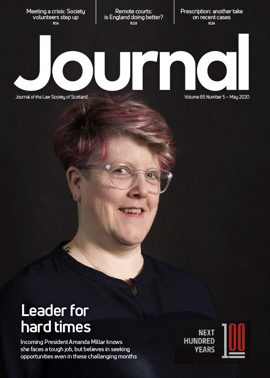Things are improving in our prisons... aren’t they?

After years of Howard League Scotland campaigning to reduce Scotland’s woefully high prison population, the unprecedented circumstances of the COVID-19 crisis have brought an unwelcome urgency to its calls. Whilst acknowledging the tragedy that triggered Government action, we welcomed the Cabinet Secretary’s announcement on 21 April that the first wave of prisoners would be released under provisions contained in the Coronavirus (Scotland) Act 2020.
At last, our (evidence-based) pleas were being heeded. It was recognition that, aside from the problems of overcrowding in normal conditions, prisons were the perfect breeding ground for the COVID-19 infection; that social distancing was almost impossible; and that the issue was a public health one, not simply a prison health one. People have often spoken of prisons as “incubators” (usually meaning of crime, or addictions). Right now, that could be all too literally true.
The picture looked promising: whilst prison visits had been suspended, alternative means of communicating with family via videoconferencing and mobile phones were being explored. The presumption against the granting of home detention curfew had been dropped. Regime restrictions were being mitigated by increased phone credit, suspension of TV rental charges and the maintenance of prison wages for those unable to work. A remote prison monitoring framework was being adopted to ensure that prisoners’ human rights were upheld.
Pressure, formal and informal, in writing and on social media to the Cabinet Secretary, Justice Committee, and HM Inspectorate of Prisons in Scotland, had not been in vain. The amplification of messages from the UN Commissioner for Human Rights, the Council of Europe’s Committee for the Prevention of Torture and Inhuman or Degrading Treatment or Punishment, and the World Health Organisation had reaped the benefits we had hoped for.
So, are things really improving?
Howard League Scotland is determined that any gains made are not squandered by taking them for granted, or as importantly, by not interrogating them properly. This means it is necessary to keep asking the important questions and checking that assurances are kept.
Where are the mobile phones which were promised?
Prison visits were suspended on 24 March and the mobile phones required to maintain family contact have been purchased, but due to “legal, security and operational reasons” are not yet in use. This does not support the Council of Europe Committee’s statement of principles, under which “any restrictions on contact with the outside world, including visits, should be compensated for by increased access to alternative means of communication (such as telephone or Voice-over-Internet-Protocol communication)”.
We’re on it.
Where are the prison-specific COVID-19 related data?
On 27 March, the Scottish Prison Service (SPS) website reported that 111 individuals across 10 establishments were self-isolating. These two figures were then updated daily. On 15 April, the daily figures of numbers of individuals self-isolating and the number of establishments affected were augmented by the figure of how many individuals had confirmed COVID-19. While this information continues to be published on a daily basis, as we have repeatedly pointed out this only becomes useful in gauging whether the situation is improving or deteriorating, if we have prison-specific data. Under acknowledged pressure from us, the Cabinet Secretary stated on 24 April that he will liaise with SPS over whether this data can be published.
We’ll keep pushing.
How will conditions in prisons be monitored during COVID-19 when prison inspections have been suspended?
We’ve fed into HM Inspectorate’s remote monitoring framework, highlighting the need for independent assessment of information reported by SPS, and await publication of the liaison visits framework. It will need to pay particular attention to ensuring that the voices of prisoners in isolation are represented; that levels of self-harm are correctly reported; and that an appropriate distinction is made between solitary confinement and medical isolation. We’re also conscious of the level of discretion afforded to individual prison officers in the Prisons and Young Offenders Institutions (Scotland) Amendment Rules 2020 and that checks and balances will be required to safeguard against its abuse.
We’re watching.
More questions
How many people are being released on home detention curfew each week, now that the presumption against doesn’t apply? How much use is being made of prison governors’ right of veto to emergency releases? What is being done to minimise the use of remand, given that untried prisoners are excluded from early release?
Howard League Scotland will ensure that these questions are answered and will monitor progress in the weeks ahead.
Perspectives
Features
Briefings
- Steps to restraining the press
- The CJRS: a developing picture
- COVID-19 and AWI: the Society's blueprint
- Give me liberty or give me an ECHR-compliant lockdown!
- Pensions and the pandemic
- Secure digital signatures: moving forward in a crisis
- PSG: progress during the pandemic
- In-house, from home
- Scottish Solicitors' Discipline Tribunal






